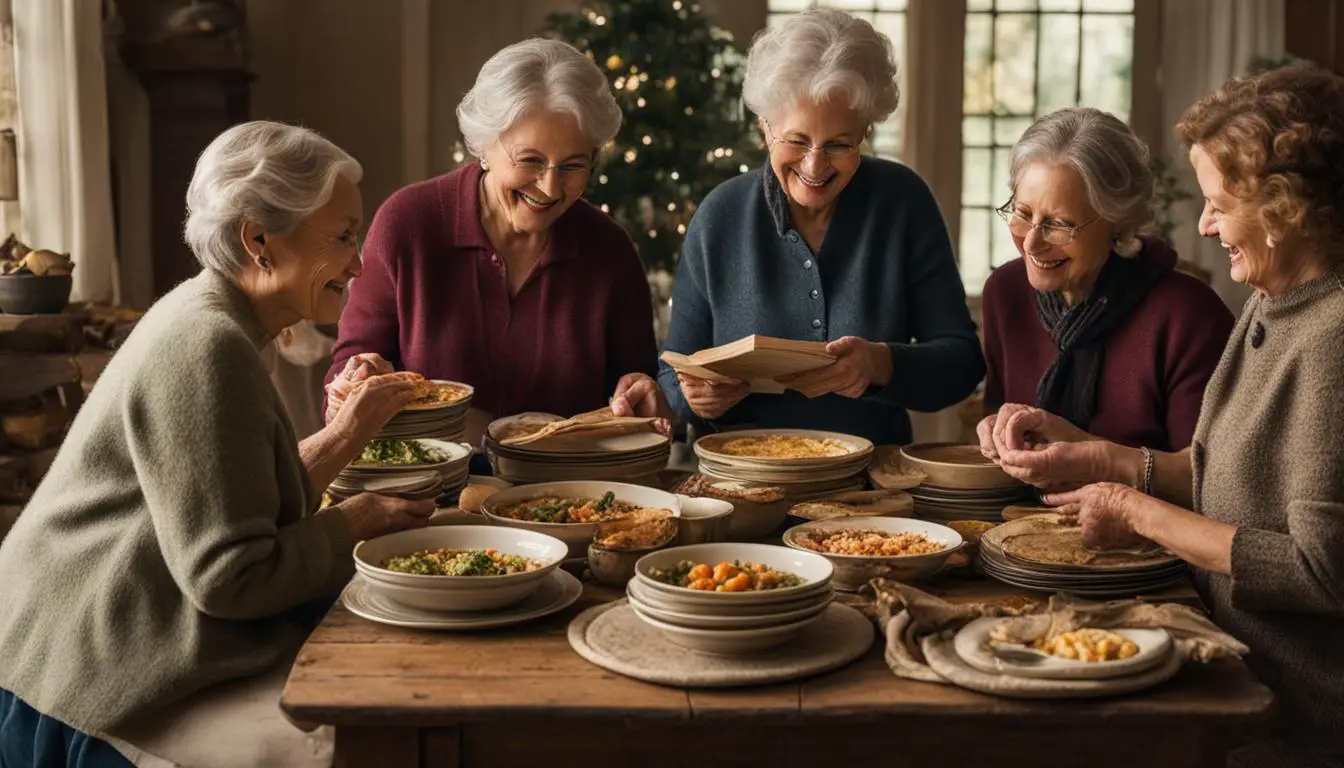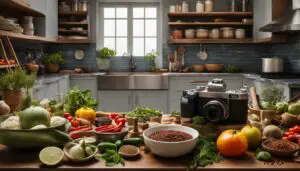Originally posted on January 9, 2024 @ 5:57 am
Have you ever wondered why recipes often come with stories and anecdotes? It’s because food is more than just sustenance. It’s deeply intertwined with our personal and cultural experiences, making it a powerful medium for storytelling. Recipes with stories preserve culinary traditions, showcase the importance of food narratives, and highlight the historical and cultural significance of dishes.
In this article, we will explore why recipes have stories and how they enrich our culinary experiences. Join us on a journey through the world of culinary traditions and food culture to discover the heartwarming reason behind the stories that accompany the recipes we love.
Contents
- 1 The Origin of Recipe Stories
- 2 The Emotional Connection to Recipes
- 3 Recipe Headnotes and the Internet
- 4 Storytelling and Cultural Heritage
- 5 Personal Stories and Recipe Sharing
- 6 Food as a Universal Language
- 7 Recipes as Time Capsules
- 8 The Intersection of Food, Stories, and Photography
- 9 The Influence of Personal Experience on Recipe Blogging
- 10 The Joy of Recipe Sharing and Connection
- 11 Conclusion
- 12 FAQ
- 12.1 Why do recipes have stories?
- 12.2 What is the origin of recipe stories?
- 12.3 What is the emotional connection to recipes?
- 12.4 How do recipe headnotes and the internet relate?
- 12.5 What is the role of storytelling in preserving cultural heritage?
- 12.6 How do personal stories contribute to recipe sharing?
- 12.7 How does food act as a universal language?
- 12.8 What is the historical significance of recipes?
- 12.9 How does photography intersect with food stories?
- 12.10 How does personal experience influence recipe blogging?
- 12.11 What brings joy and connection in recipe sharing?
- 12.12 Why are food narratives important?
- 13 Source Links
Key Takeaways:
- The stories behind recipes help preserve culinary traditions.
- Recipes with stories showcase the importance of food narratives.
- Recipes with stories highlight the historical and cultural significance of dishes.
- Culinary traditions and food culture are deeply intertwined with our personal and cultural experiences.
- Recipes with stories enrich our culinary experiences and create a deeper connection with the food we enjoy.
The Origin of Recipe Stories
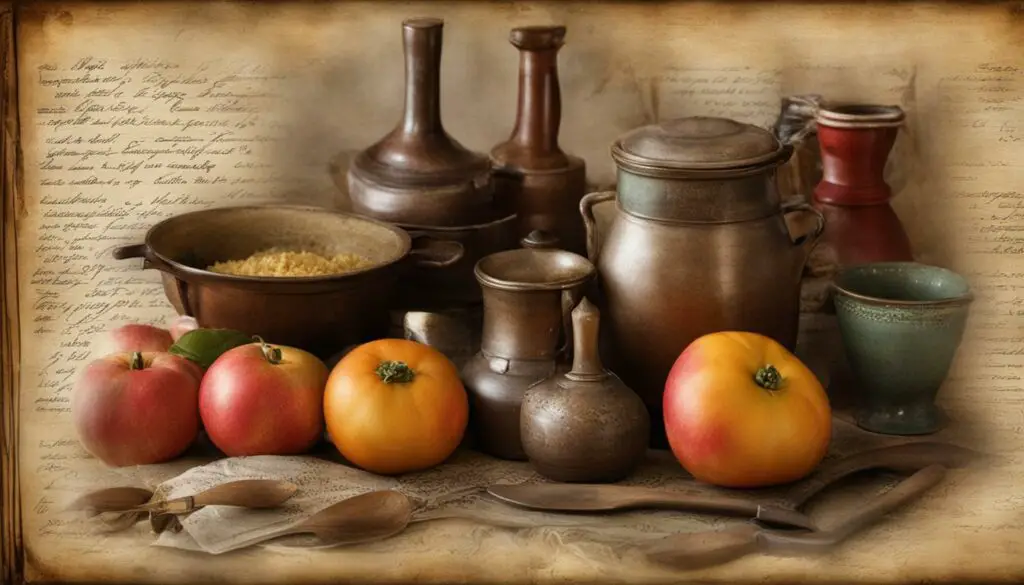
Have you ever wondered why recipes often come with stories? The tradition of including narratives with recipes has a fascinating history. While it’s not true that index cards were originally intended for recipes, the practice of sharing stories alongside culinary instructions has evolved over time. Let’s delve into the origins of recipe storytelling and how it has become an integral part of our culinary experiences.
In the past, recipes were not just about ingredients and cooking techniques; they were accompanied by context and lifestyle advice. Publishers aimed to create a connection between the readers and the dish by providing additional information that allowed them to envision a certain lifestyle. By sharing stories alongside recipes, people could better understand the cultural and historical significance of the dish.
With the advent of social media and personal blogs, recipe headnotes have gained even more popularity. Individuals now have the opportunity to infuse their personal stories and cultural backgrounds into their recipes. This allows for a deeper connection between the reader and the creator, as personal narratives bring authenticity and relatability to the dish.
“Food is our common ground, a universal experience.” – James Beard
The rise of the internet has transformed recipe headnotes into a powerful storytelling medium. People from diverse backgrounds can now share their culinary stories with a wide audience, fostering a sense of community and connection. Whether it’s a cherished family recipe passed down through generations or a new creation inspired by cultural influences, recipe headnotes provide a platform for individuals to express themselves and celebrate their unique culinary journeys.
This image showcases the evolution of recipe storytelling, capturing the essence of the historical and cultural significance of recipes.
| Benefits of Recipe Stories | Examples |
|---|---|
|
|
The Emotional Connection to Recipes

Recipes have become more than just lists of ingredients and instructions. They now serve as a form of emotional investment for many people. Cooking and sharing recipes enable us to connect with others on a deeper level. As Michael Pollan explains, cooking is a form of intimacy and an expression of generosity. Sharing our personal stories through recipes allows us to forge connections with other people, cultures, and times.
Connecting Through Food
Food has a unique ability to evoke emotions and create memories. When we prepare a beloved family recipe or recreate a dish from our travels, we are transported to significant moments in our lives. The act of cooking and sharing these recipes becomes a way to express our love, heritage, and experiences.
Imagine sitting down to a table filled with dishes that have been passed down through generations. Each bite tells a story, connecting us with our ancestors and the traditions they cherished. These recipes become a thread that weaves together our past, present, and future.
“Food is our common ground, a universal experience.” – James Beard
Culinary Crossroads
Recipes also bridge cultural divides, allowing us to explore and appreciate different traditions. Through food, we can embrace new flavors, techniques, and ingredients, broadening our culinary horizons. By sharing recipes and their accompanying stories, we create a sense of belonging within a larger global community.
Exploring the Emotional Journey
Let’s take a moment to delve into the emotional investment and connection that recipes offer us. Think about the last time you shared a meal with loved ones. Remember the laughter, the stories, and the shared experience of breaking bread together. Food has the power to nourish not only our bodies but also our souls.
- Recipes are a vessel for precious memories, reminding us of special occasions, holiday gatherings, and cherished moments spent with family and friends.
- They allow us to express our creativity and individuality in the kitchen, whether it’s through adding a personal touch to a classic recipe or experimenting with flavors and techniques.
- Recipes can also provide comfort and solace during challenging times. The familiar tastes and smells of a favorite dish can be reassuring and offer a sense of stability.
By acknowledging the emotional journey that recipes take us on, we gain a deeper appreciation for the role food plays in our lives.
A Table of Connections
| Connection | Recipes |
|---|---|
| Family | Passed down through generations, these recipes carry the stories and traditions of our ancestors. |
| Culture | Recipes allow us to celebrate and honor our heritage, connecting us with our roots. |
| Community | Sharing recipes builds bonds, whether it’s within our neighborhood, online food communities, or cooking clubs. |
| Memories | Recipes evoke nostalgia, bringing back moments of joy, love, and shared experiences. |
| Discovery | Exploring and trying new recipes opens doors to diverse cultures and culinary traditions. |
Recipe Headnotes and the Internet

The rise of personal blogs and social media platforms like Pinterest has revolutionized the way recipes are shared and consumed. Alongside the mouthwatering photographs and detailed instructions, recipe headnotes have gained significant popularity, adding a personal touch to the culinary experience.
Recipe headnotes are personal narratives written by individuals, irrespective of their culinary expertise. These heartfelt stories go beyond the ingredients and techniques, captivating readers with tales of family traditions, cherished memories, and cultural backgrounds.
“Baking this apple pie always takes me back to my childhood, when my grandmother would lovingly prepare it for every family gathering.”
These personal narratives are not confined to professional chefs or experienced cooks; anyone with a passion for food can become a storyteller. From first-time bakers to seasoned home cooks, recipe headnotes allow individuals to share their unique culinary journeys, creating a sense of community and connection.
In the fast-paced digital age, where attention spans are scarce, it’s remarkable to see the time and energy people are willing to invest in reading and writing recipe headnotes. This showcases the genuine interest and value placed on personal storytelling in the culinary world.
Sharing personal stories through recipe headnotes fosters a sense of community. Readers not only learn new recipes but also gain insights into the lives and experiences of others. It’s a way to bridge gaps, appreciate diverse culinary traditions, and embark on a shared culinary adventure.
Community Sharing and Connection
Recipe headnotes have become a platform for community sharing, where individuals can form connections and engage in conversations around their shared love for food.
Through comments sections, social media groups, and dedicated recipe sharing platforms, like-minded individuals can engage in discussions, ask questions, and offer variations or suggestions. Recipes become a catalyst for building relationships, sparking conversations, and fostering a sense of belonging.
Engaging in community sharing through recipe headnotes not only cultivates culinary skills but also expands cultural horizons. From trying out new flavors to exploring global food traditions, the opportunity for discovery and growth is endless.
The Power of Personal Storytelling
Recipe headnotes, with their personal storytelling element, have the power to evoke emotions and create a deeper connection between the cook and the reader. These narratives add a layer of authenticity, allowing us to glimpse into the lives, experiences, and traditions of others through the language of food.
They bring back memories of cherished moments, celebrating the everyday magic that happens in the kitchen. Whether it’s recreating a cherished family recipe or discovering a new food culture, recipe headnotes have the power to transport us to different times and places through the art of storytelling.
| Benefits of Recipe Headnotes on the Internet | |
|---|---|
| 1 | Facilitates community sharing and connection |
| 2 | Preserves personal and cultural food stories |
| 3 | Enriches the culinary experience |
| 4 | Expands culinary knowledge and cultural horizons |
Recipe headnotes have become an integral part of the online food community, adding depth, emotion, and connection to the culinary journey. As technology continues to evolve, we can expect recipe headnotes to further thrive and inspire us to explore the world one recipe at a time.
Storytelling and Cultural Heritage
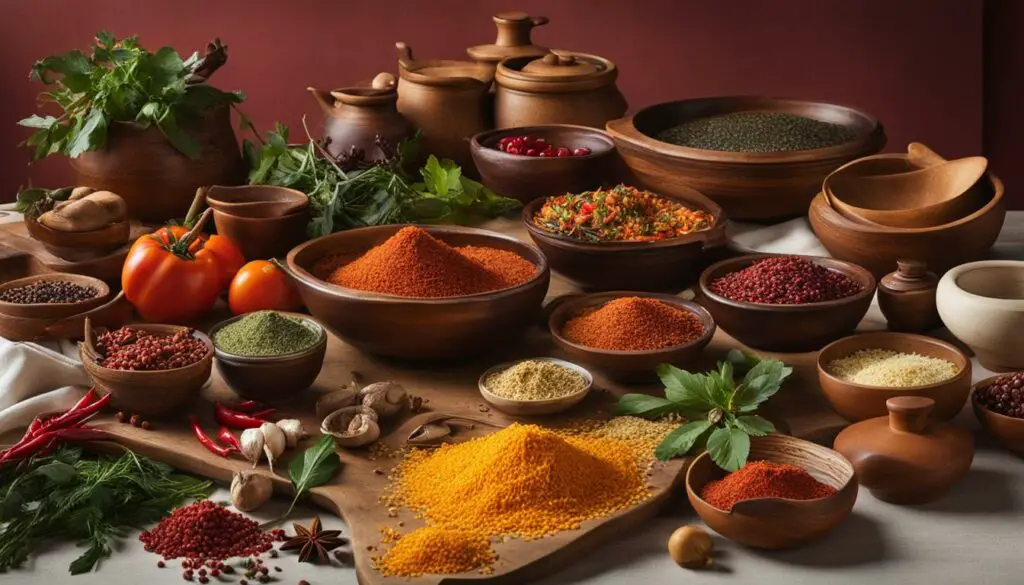
Recipes and the stories behind them are powerful vessels for preserving cultural heritage. They offer a glimpse into different cuisines, cooking techniques, and traditional ingredients, allowing us to immerse ourselves in the richness of a culture. Through these stories, the essence of a community is captured, revealing the traditions, values, and customs that have shaped its culinary identity for generations.
In every dish, there is a narrative waiting to be shared. The age-old recipes passed down from one generation to another carry the weight of history and heritage. They hold the secrets of ancient cooking methods and the significance of certain ingredients. These stories not only celebrate the diverse flavors and aromas of a particular culture but also serve as a testament to the resilience and adaptability of its people.
Preserving Culinary Traditions
Storytelling in cooking is a powerful tool for preserving culinary traditions. It ensures that the knowledge and expertise of past generations are not lost but instead cherished and passed on. By sharing these stories, we inspire future generations to continue the legacy, keeping culinary traditions alive and thriving.
“Cultural heritage is not just an artifact; it is also the knowledge, skills, and oral traditions that are passed down from generation to generation.” – UNESCO
Preserving culinary traditions goes beyond the flavors and techniques. It is about preserving the stories that define a culture and its people. These stories serve as a bridge between the past and the present, connecting us to our roots and creating a sense of belonging and identity.
The Power of Storytelling in Cooking
Storytelling in cooking is more than just recounting the history of a recipe; it is about creating a connection between the cook and the diner. It adds depth and meaning to the culinary experience, elevating it from a mere combination of ingredients to a profound journey of culture and emotion.
Through the art of storytelling, we honor the contributions of the individuals who have shaped our culinary heritage. We pay homage to the generations of skilled cooks who have poured their love and passion into each dish. And we create a sense of shared experience, inviting others to partake in the cultural tapestry that defines us.
Personal Stories and Recipe Sharing
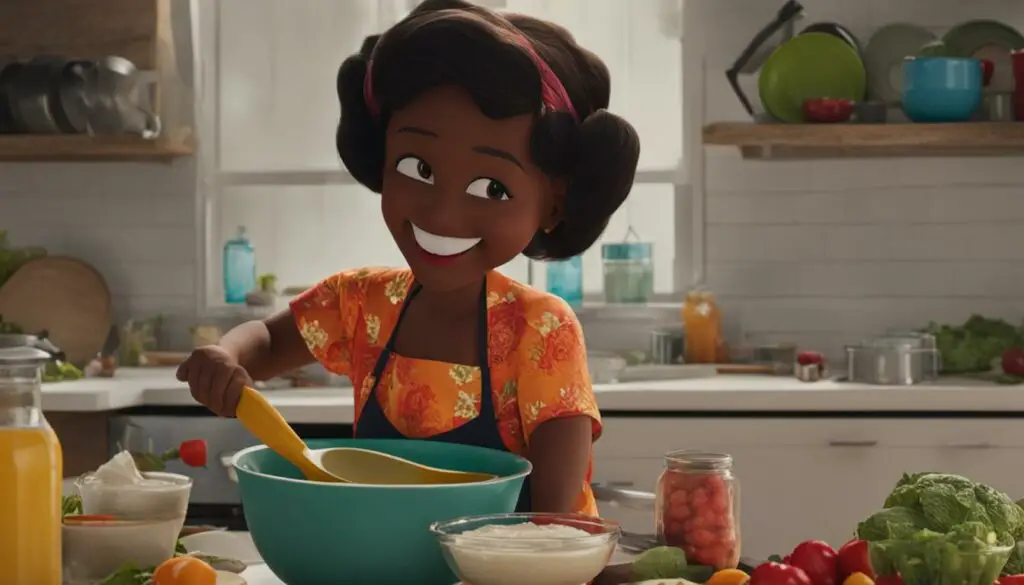
When it comes to sharing recipes, many individuals go beyond providing a simple list of ingredients and instructions. They accompany their recipes with personal stories and anecdotes that add depth and meaning to the dish. These personal stories behind recipes create a sense of connection and allow us to share our experiences, traditions, and memories through food.
Family recipes, in particular, carry a weight of nostalgia and love. Passed down through generations, these recipes are often accompanied by stories of cherished moments, family gatherings, and special occasions. Sharing these family recipes allows us to keep our heritage alive and continue the traditions that have shaped us.
Moreover, recipes serve as a form of self-expression. Each cook brings their unique creativity and passion to the kitchen, infusing their personal touch into the dishes they create. Recipes with personal stories provide a glimpse into the cook’s life, showcasing their culinary journey, inspirations, and influences. Cooking becomes a means of expressing oneself and sharing a part of who we are with others.
Through the personal stories shared alongside recipes, a sense of connection is forged between the reader and the creator. As we read these stories, we can relate to the emotions, memories, and experiences expressed by the cook. It creates a shared understanding and appreciation for the power of food to evoke emotions and create lasting memories.
“Food is our common ground, a universal experience.” – James Beard
Food as a Universal Language
Food has a unique ability to transcend language and cultural barriers, serving as a universal language that brings people together. Through the stories behind recipes, we can open up conversations, foster understanding, and create connections between diverse cultures and communities.
The act of exploring different cuisines allows us to appreciate the culinary diversity that exists around the world. Each dish tells a story, reflecting the unique cultural traditions, ingredients, and flavors of a particular region. By understanding the stories behind these dishes, we gain a deeper appreciation for the richness and diversity of food traditions.
Food has the power to unite us in shared experiences and create opportunities for cultural exchange. When we come together to share a meal, we are not just nourishing our bodies; we are also creating connections and building bridges of understanding.
“Food is our common ground, a universal experience.” – James Beard
The Culinary Diversity of Food
One of the most beautiful aspects of food is its ability to showcase the culinary diversity that exists globally. From fragrant spices in Indian curries to delicate flavors in Japanese sushi, each cuisine tells a unique story shaped by history, geography, and cultural customs.
| Cuisine | Flavors | Ingredients |
|---|---|---|
| Italian | Rich, bold, and savory | Tomatoes, olive oil, herbs |
| Thai | Spicy, sweet, and tangy | Chili peppers, coconut milk, lemongrass |
| Mexican | Spicy, smoky, and vibrant | Chili peppers, corn, beans |
Table: Culinary Diversity in Flavors and Ingredients
These different flavors and ingredients not only appeal to our taste buds but also offer a window into different cultures and traditions. By embracing culinary diversity, we can celebrate the richness of our world and build bridges of understanding.
Food truly is a universal language that connects us all, allowing us to share our stories, traditions, and experiences through the power of taste and flavor. So let’s continue to explore, embrace, and appreciate the culinary diversity that surrounds us.
Recipes as Time Capsules
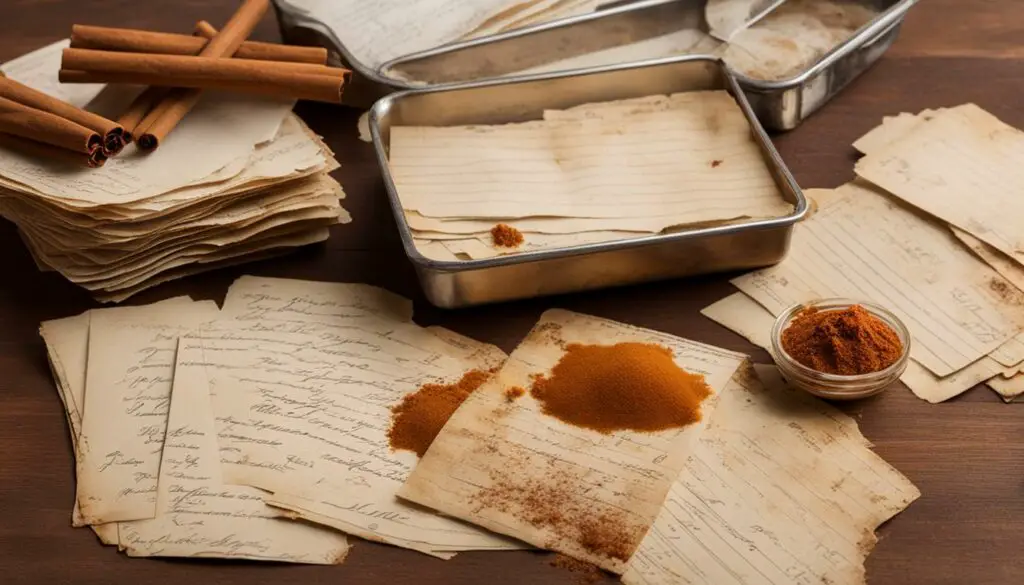
Recipes have a unique historical significance, acting as time capsules that capture specific moments and cultural contexts. They provide valuable insights into the culinary practices, ingredients, and cooking techniques of different eras. By preserving recipes and the stories behind them, we ensure that our cultural heritage and culinary history are not forgotten.
Recipes hold the power to transport us back in time, allowing us to experience the flavors and traditions of bygone eras. They document the ever-evolving nature of food and reflect the cultural influences and societal values of their time.
Just like an old photograph or a handwritten letter, a recipe can evoke nostalgia and memories of a particular time and place. It can remind us of family gatherings, cherished moments, and the unique tastes that defined our past.
The historical significance of recipes goes beyond the flavors they capture. They provide a window into the lives of our ancestors, offering glimpses into their daily routines, customs, and the resources available to them.
**”Recipes can tell us not only what people ate but also how they prepared and enjoyed their meals. They provide us with a tangible connection to the past, allowing us to understand the cultural and social contexts that shaped our culinary heritage.”**
The Culinary Chronicles of Civilizations
Throughout history, recipes have played a pivotal role in preserving the gastronomic heritage of civilizations. From ancient manuscripts to cookbooks passed down through generations, recipes document the collective wisdom of societies and their culinary traditions.
Consider, for example, the valuable insights gained from ancient Roman recipes, offering a glimpse into the lavish feasts of emperors and common citizens alike. These recipes reveal the use of exotic ingredients, intricate cooking methods, and the importance of food in Roman society.
Similarly, the medieval cookbooks of Europe provide us with a rich tapestry of recipes that highlight the social structure of the time, the influence of religion on food, and the importance of feasting as a display of wealth and power.
Recipes also reflect the impact of exploration and the exchange of goods between different cultures. The spice trade, for instance, left a lasting imprint on recipes, introducing exotic flavors and ingredients that became integral to the cuisines of various nations.
Unveiling Culinary Traditions through Recipes
Recipes serve as cultural artifacts, revealing the immense diversity and beauty of culinary traditions across the globe. They are a testament to the creativity and resourcefulness of different communities, showcasing unique flavor combinations and cooking techniques.
Whether it’s the fiery curries of India, the delicate sushi of Japan, or the hearty stews of Latin America, recipes provide us with a taste of the cultural heritage and ancestral knowledge passed down through generations.
**“Recipes are not simply instructions for preparing a dish; they are gateways to understanding the essence of a culture, its values, and its relationship with food.”**
A Treasured Recipe As Cultural Legacy
Recipes, often handed down from generation to generation, are a precious inheritance. They carry within them the stories and memories of our ancestors, connecting us to our roots and preserving our cultural identity.
These treasured family recipes weave a narrative that transcends time, creating a bridge between past and present. They remind us of who we are, where we come from, and the traditions that have shaped us.
Through recipe sharing and the preservation of culinary traditions, we ensure that the historical significance of recipes continues to be celebrated and cherished.
Exploring the Past Through Recipes
Let’s take a journey into the past and uncover a recipe that encapsulates a specific historical moment. Today, we delve into a recipe from the Renaissance era: the famed “Sallet of Herbs” from the cookbook The Good Housewife’s Jewel (1596).
| Ingredients | Instructions |
|---|---|
|
|
This simple recipe reflects the emphasis on fresh herbs and greens during the Renaissance period, a departure from the heavy and spiced dishes prevalent in medieval cuisine. It offers a glimpse into the changing culinary tastes and the growing influence of the Renaissance movement.
Recipes like the Sallet of Herbs enable us to step into the shoes of those who lived centuries ago and experience a piece of their culinary legacy.
The Intersection of Food, Stories, and Photography
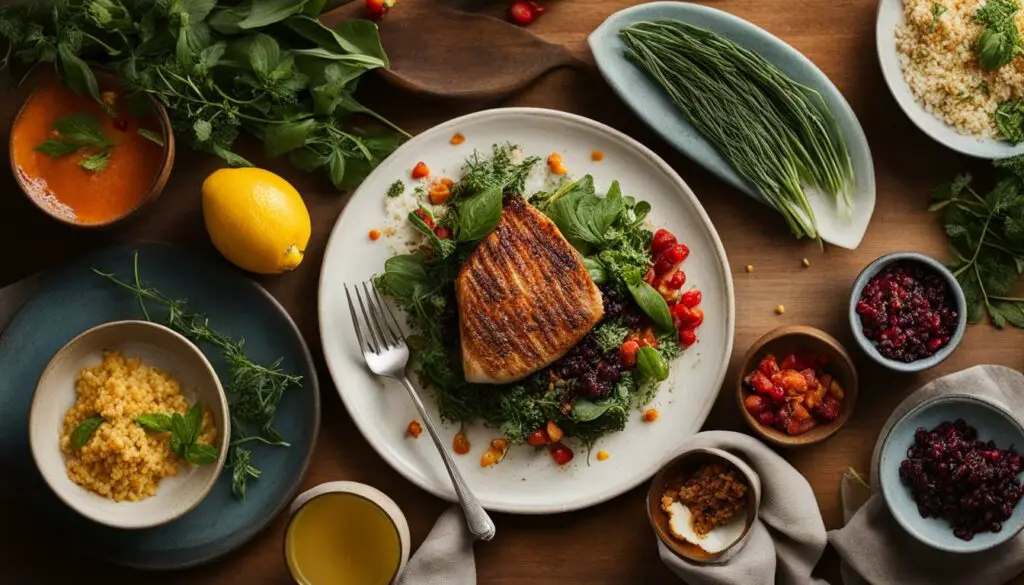
In today’s digital age, recipe storytelling has evolved to include not only written narratives but also visual storytelling through food photography. Food bloggers and photographers use their images to evoke emotions and tell stories, complementing the written narratives. This visual element enhances the overall recipe experience and captures the readers’ attention, enticing them to try the dish and delve into the accompanying story.
Food photography plays a vital role in captivating audiences and bringing recipes to life. By carefully capturing the textures, colors, and details of the dish, photographers create visually stunning images that inspire readers and make them crave the food they see. Through a well-composed photograph, the essence of the recipe can be conveyed, helping readers envision the flavors, aromas, and textures that await them.
Storytelling through visuals adds depth and dimension to recipes, creating a more immersive experience for the reader. It allows them to connect with the dish on a sensory level, enhancing their understanding and appreciation of the recipe. Visual storytelling enables food bloggers and photographers to convey cultural and personal narratives, sharing the stories behind the dish and the significance it holds.
Food blog evolution has witnessed the integration of food photography as an integral component of recipe storytelling. In the early stages of food blogging, images were often an afterthought, consisting of basic snapshots. However, the appreciation for visually appealing content has grown exponentially, prompting bloggers to invest time and effort into crafting stunning food photographs.
The evolution of technology and the popularity of social media platforms such as Instagram have further fueled the importance of food photography. Readers now expect more than just a list of ingredients and instructions; they desire a visually captivating experience accompanied by engaging narratives.
“Food photography has become an art form, capable of conveying emotions and stories through the lens of a camera. It allows readers to connect with the recipe on a deeper level, bridging the gap between words and visuals.” – Emma Johnson, Food Blogger
The power of food photography lies in its ability to create an emotional connection and inspire action. When readers are visually enticed by a mouthwatering image, they are more likely to try the recipe and share their experience with others. It serves not only as a means of storytelling but also as a call to action that motivates readers to engage with the recipe and forge their own culinary tales.
| Photography Tips: | Benefits: |
|---|---|
| Use natural lighting for a soft and appetizing effect. |
|
| Experiment with different angles and perspectives. |
|
| Consider the composition and styling of the photograph. |
|
| Edit and enhance the image to bring out the best qualities. |
|
The Influence of Personal Experience on Recipe Blogging
When it comes to recipe blogging, personal experiences play a significant role in creating meaningful connections through food. Recipe bloggers have embraced the power of storytelling by infusing their blog posts with their own joys, challenges, and memories associated with the dishes they share.
By bringing their personal accounts into their writing, bloggers cultivate a sense of authenticity and relatability that allows readers to connect with them on a deeper, more personal level. As readers delve into the stories behind the recipes, they gain insight into the blogger’s journey, creating a bond that goes beyond the food on the plate.
Sharing personal experiences in recipe blogging is an opportunity to showcase not only culinary creations but also the stories and emotions that accompany them. The struggles, triumphs, and moments of nostalgia shared by bloggers spark conversations, evoke memories, and elicit a shared connection through food.
Imagine stumbling upon a recipe for your favorite childhood treat, only to find that the blogger’s story mirrors your own cherished memories. Suddenly, you feel understood, seen, and connected to a stranger through the power of food. These personal narratives bridge gaps and bring people together, forging a community centered around the joy of cooking, eating, and storytelling.
“Food brings people together on many different levels. It’s nourishment of the soul and body; it’s truly love.” – Giada De Laurentiis
The Joy of Recipe Sharing and Connection
Sharing recipes goes beyond exchanging culinary ideas; it creates a profound sense of joy and a strong community bond. Whether it’s during lively family gatherings, passionate cooking clubs, or vibrant online platforms, the act of sharing recipes allows us to connect with others who share our love for food. It fosters a sense of belonging and creates opportunities for collaboration, learning, and building connections with people from diverse backgrounds.
Imagine a gathering where everyone brings a favorite family recipe to share. As you bite into a slice of Aunt Martha’s famous apple pie, you not only savor the delicious flavors but also connect with the memories and stories she shares about the recipe. These moments of culinary bonding strengthen family ties and create lasting traditions that are passed down through generations.
“Sharing food is the foundation of human connection.”
Arturo, a member of a local cooking club, shares his experience: “Being part of a cooking club has brought so much joy into my life. We come together to prepare and share recipes from different cultures, learning from one another and forming lasting friendships. It’s a beautiful blend of culinary exploration and genuine human connection.”
Online platforms have also played a significant role in connecting food enthusiasts from all corners of the globe. Whether through recipe blogs, social media groups, or dedicated recipe-sharing websites, individuals can now easily exchange recipes, stories, and cooking tips, creating a virtual community centered around the joy of recipe sharing.
The Sense of Community and Culinary Bonding
When we share recipes, we bring people together and create a sense of community. It’s not just about the food; it’s about the shared experiences and the stories behind the recipes. We bond over our collective love for culinary exploration and the joy of creating something delicious.
Recipe sharing allows us to celebrate our cultural heritage and discover new flavors and techniques. It opens doors to different traditions and fosters an appreciation for the diverse culinary landscapes around the world. Through these connections, we gain a deeper understanding of our shared humanity and develop a sense of empathy and respect for one another.
So, the next time you come across a mouthwatering recipe or a heartwarming culinary story, remember the joy that comes from sharing it with others. Embrace the sense of community and culinary bonding that comes along with it. Share your recipes, connect with fellow food lovers, and let the joy of recipe sharing create a tapestry of flavors, stories, and connections that enrich our lives.
Conclusion
Recipes have stories because food is not just about sustenance; it’s about culture, connection, and memories. The stories behind recipes enrich our culinary experiences, preserve cultural heritage, and bring people together. By sharing our personal narratives through recipes, we honor our culinary traditions and create lasting connections with others. So the next time you come across a recipe with a story, take a moment to savor not just the flavors but also the deeper meaning behind the dish.
FAQ
Why do recipes have stories?
Recipes have stories because food is deeply intertwined with our personal and cultural experiences. The stories behind recipes help preserve culinary traditions, showcase the importance of food narratives, and highlight the historical and cultural significance of dishes.
What is the origin of recipe stories?
While it is not true that index cards were originally intended for recipes, the tradition of including stories with recipes has evolved over time. In the past, recipes were often published alongside context and lifestyle advice to make readers feel a connection with the dish and envision a certain lifestyle.
What is the emotional connection to recipes?
Recipes serve as more than just lists of ingredients and instructions. They are a form of emotional investment and a way to connect with others on a deeper level. Cooking and sharing recipes allow us to forge connections with other people, cultures, and times.
How do recipe headnotes and the internet relate?
The rise of personal blogs and social media platforms like Pinterest has led to the proliferation of recipe headnotes. These personal narratives are written by anyone, regardless of their culinary expertise, and can be found on various online platforms. Recipe storytelling fosters community sharing and connections.
What is the role of storytelling in preserving cultural heritage?
Recipes and the stories behind them play a crucial role in preserving cultural heritage. Through recipes, we can learn about different cuisines, cooking techniques, and traditional ingredients. The stories behind recipes capture the essence of a culture and provide insight into the traditions and values of a community.
How do personal stories contribute to recipe sharing?
Many individuals share recipes accompanied by personal stories and anecdotes. Family recipes carry the weight of nostalgia and love, and sharing them allows us to keep our heritage alive. Additionally, individuals often use recipes as a form of self-expression, showcasing their creativity and passion for food.
How does food act as a universal language?
Food transcends language and cultural barriers, acting as a universal language that brings people together. The stories behind recipes open up conversations and foster understanding between cultures. Exploring different cuisines and understanding the stories behind the dishes allow us to appreciate the diversity and richness of food traditions around the world.
What is the historical significance of recipes?
Recipes have historical significance and can act as time capsules, capturing specific moments and cultural contexts. They provide insights into the culinary practices, ingredients, and cooking techniques of different eras. By preserving recipes and the stories behind them, we ensure that our cultural heritage and culinary history are not forgotten.
How does photography intersect with food stories?
In today’s digital age, recipe storytelling has evolved to include not only written narratives but also visual storytelling through food photography. Food bloggers and photographers use their images to evoke emotions and tell stories, complementing the written narratives. This visual element enhances the overall recipe experience and captures the readers’ attention.
How does personal experience influence recipe blogging?
Recipe bloggers often infuse their personal experiences into their blog posts, sharing their joys, challenges, and memories associated with the dish. These personal accounts create a sense of authenticity and relatability, allowing readers to connect with the blogger on a more personal level. By sharing their stories, bloggers not only showcase their culinary creations but also create a community centered around food and storytelling.
What brings joy and connection in recipe sharing?
The act of sharing recipes and the stories behind them brings joy and fosters a sense of community. Whether it’s through family gatherings, cooking clubs, or online platforms, sharing recipes allows us to bond over a shared love of food. It creates opportunities for collaboration, learning, and building connections with people from diverse backgrounds.
Why are food narratives important?
Recipes have stories because food is not just about sustenance; it’s about culture, connection, and memories. The stories behind recipes enrich our culinary experiences, preserve cultural heritage, and bring people together. By sharing our personal narratives through recipes, we honor our culinary traditions and create lasting connections with others.

